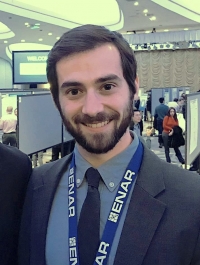
Hometown: Rochester, NY
Education: BS in Psychology (minor in Mathematics and Statistics), Haverford College
Pursuing PhD in Biostatistics
Interest that took him by surprise: Coming into the biostatistics program I knew almost nothing about neuroimaging and was fairly convinced that I wanted to work on methods for clinical trials. Then a professor at another university recommended that I get in touch with [Assistant Professor of Biostatistics] Taki Shinohara. I went out of my way to meet with Taki and ended up working with him for two of my first three lab rotations—and every semester since then.
Many of the statistical methods we’ve been developing aim to detect subtle features of brain lesions. These types of methods can potentially help clinicians make accurate diagnoses and prognoses for multiple sclerosis patients.
How he’s making an impact (now there IS an app for that): Established investigators in a field tend to know intuitively which topics are up-and-coming or declining, and which people usually study in tandem. But it can be quite daunting for those who are new to get even a surface-level picture of the field; I experienced this first-hand. I decided to create a place where new graduate students or young researchers could go to get a feel for the neuroimaging landscape.
I also wanted to help people visualize new connections they could draw, between topics that historically have been unrelated in neuroimaging research.
What his project taught him: The topics that have spiked most dramatically in the past few years are resting state and functional connectivity. This research studies not only individual regions of the brain, but the relationships between regions. Thanks to researchers like Penn’s Danielle Bassett, we now have valuable new insights about the brain in health and disease.
In addition, on the methods side researchers are working tirelessly to address the issue of motion in the data—specifically the poor image quality that results from patients moving in the scanner. And prediction has become popular—implying a greater focus on obtaining accurate diagnoses and prognoses from the data.
It’s interesting to me that structural connectivity isn’t yet among the most popular topics. This suggests there might be room for more people to investigate and interpret the physical connections between brain regions.
What statistics can teach you about Republican candidates and scary TV: Many people outside of scientific research tend to be bored or intimidated by statistics. As a future statistician, I believe strongly that some statistical literacy is an important tool for everyone. So in my free time I’ve been trying to apply statistical methods to questions that appeal to a broader audience. In summer 2016, I performed a simulation of the first 15 Republican primaries to determine if a different method of voting would have changed their outcomes. You can read about that here. And more recently I analyzed the emotional patterns in episodes of the sci-fi show Stranger Things. Here’s what I found out about the show’s popularity.

